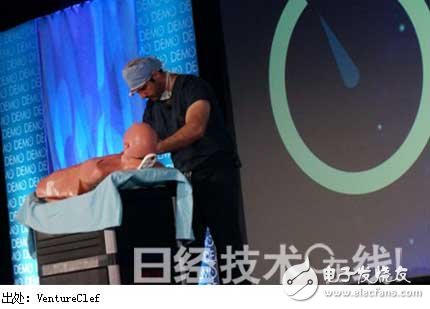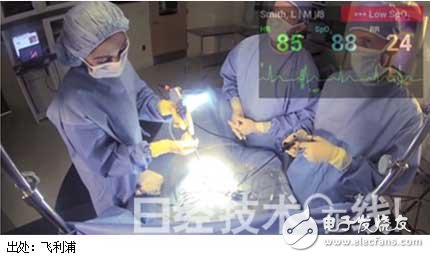In the hospital, doctors take Google glasses to see patients; in the operating room, anesthesiologists take Google glasses and observe the patient's vital signs while anesthesia. Medical trials using Google Glass have been launched at affiliated hospitals at American universities. Google Glass is making a huge difference to the medical scene.
Streaming the treatment process with Google Glass
At the DEMO conference in Santa Clara, Calif., in 2013, Kyle Samani (pictured above), PrisTIne CEO, performed a demonstration of wearing Google glasses for surgery. PrisTIne, a venture company based in Austin, Texas, is currently developing medical applications for Google Glass. The app's name is "PrisTIne CheckLists", which automates workflows in the hospital. When a complicated device such as an endoscope is sterilized after the operation, the processing steps can be displayed on the Google glasses, and the worker can follow the prompt steps.

Another application, called "PrisTIne EyeSight," offers the ability to use a camera to capture and stream the treatment after a doctor wears Google Glass. Use your smartphone or tablet to share images seen with your doctor with other doctors. Pristine proposes a variety of uses for Pristine EyeSight: When the anesthesiologist is anesthetized in the operating room, he can use Google Glass to send a video to the instructor and accept the advice of the other person as needed; in the Centralized Treatment Unit (ICU), the attending doctor can wear Google Glass broadcasts the patient's condition to the specialist through streaming media to determine treatment guidelines and so on. In addition, the instructor can also wear Google glasses for treatment, generate streaming media for the treatment process, and use it for intern training. The picture below shows a demonstration of Pristine EyeSight, which simulates a patient and generates streaming media from Google Glass.

Pilot project initiated by the University of California
After the DEMO conference, Samani introduced the development of Pristine to reporters. He said that Pristine is conducting experiments at the University of California, Irvine Medical Center (below). The pilot project was launched last month to validate its functionality and ease of use at the medical site using Google Glass and Pristine applications. The company also plans to conduct trials in other hospitals, and US medical institutions have shown strong interest in medical technology using Google Glass.
Need to integrate on Google Glass
At the same time, to apply Google Glass to the medical field, we must solve many problems. According to the US HIPPA (medical insurance related regulations), Pristine must protect the patient's personal information. Therefore, instead of using the Mirror API provided by Google, Pristine uses a way to store patient data on a hospital server. With the Mirror API, the patient's personal data is saved on Google's servers, which violates HIPPA regulations. Therefore, Pristine has developed an Android native app for use on Google Glass. On the other hand, Pristine targets these applications as a tool for taking patient status videos without the approval of the US Food and Drug Administration (FDA). When the reporter asked Samani about the company's business plan in Japan, he replied that he is currently focusing on launching business in the US, but is also discussing whether to conduct business in Japan through partners in the future.

The amount of Google Glass that can be used before it is officially available is very limited. Moreover, the system of Google glasses is still unstable, and there are many bugs. Despite these disadvantages, Pristine still prototyped the application and experimented in a university hospital. This kind of courage of venture companies is admirable. In addition, the university hospital has shown great interest in the use of Google Glass medical technology, and people feel that the "glasses diagnosis and treatment" will make great progress.
Large medical companies also introduce Google glasses
Google Glass has been considered the most suitable for medical use since its release. Philips and Accenture have released the concept of a medical system using Google Glass. Although not commercialized, the two companies demonstrated the new concept of applying Google Glass to healthcare through demonstrations in the operating room environment. The scene set for the doctor to treat the child patient during the demonstration shows the role of Google Glass at a glance.

The picture above shows the situation at the time of the demonstration. The doctors are performing anesthesia treatment in the operating room. Previously, an anesthesiologist had to look at the display set up above to monitor the patient's condition. With Google Glass, the patient's name, heart rate (85), oxygen saturation (88), and respiratory rate (24) can be displayed on the glasses, as well as a warning message with a lower blood oxygen saturation value. The new idea is to apply a medical system called "Philips IntelliVue" to Google Glass. By displaying the patient's vital signs data on Google Glass, the doctor can monitor the patient's condition while performing medical treatment without removing the line of sight from the patient. Large medical companies are adopting the form of integrating existing medical systems into Google Glass to incorporate wearable devices into medical technology.
Buying Google Glass from an optical store
According to the Wall Street Journal, VSP Global has started negotiations on Google Glass and Google. VSP Global is the largest medical insurance company in the US in the frame and lens business, with 30,000 ophthalmologists and 60 million members. VSP Global is in talks with Google about developing stylish frames and lenses for Google Glass and training ophthalmologists for Google Glass. In the United States, everyone will use VSP medical insurance when glasses are used. If the negotiations between the two parties are successful, consumers can buy Google glasses in the street shop, and the sales channels will expand rapidly. At the same time, Google Glass will also change the image of the past, from cool electronic devices to daily necessities. Just as Android smartphones are sold and popularized in street-based home appliances stores, Google Glass is also turning to the public channel and constantly adjusting its sales strategy before it is officially available.
From venture companies to large medical companies, the development of medical technology using Google Glass is accelerating. Google Glass will be officially available in early 2014. It is estimated that from 2014 onwards, doctors will wear more and more patients to see Google.

About the author :
Miyamoto and Akira
Representative of VentureClef Corporation of the United States
Born in Hiroshima Prefecture, Japan in 1955. In 1985, he was assigned to Amdahl Company in the United States by Fujitsu to carry out supercomputer business in North America. In 2003, VentureClef was established in Silicon Valley to conduct research on software-leading technologies centered on venture companies. Currently, based on his 20 years of experience in Silicon Valley, he analyzes technology trends.
Forehead Thermometer,Forehead Infrared Thermometer,Medical Forehead Thermometer,Noncontact Infrared Forehead Thermometer
Ningbo Anbo United Electric Appliance Co.,ltd , https://www.airfryerfactory.com